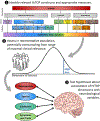The hierarchical taxonomy of psychopathology and the search for neurobiological substrates of mental illness: A systematic review and roadmap for future research
- PMID: 39480338
- PMCID: PMC11529694
- DOI: 10.1037/abn0000903
The hierarchical taxonomy of psychopathology and the search for neurobiological substrates of mental illness: A systematic review and roadmap for future research
Abstract
Understanding the neurobiological mechanisms involved in psychopathology has been hindered by the limitations of categorical nosologies. The Hierarchical Taxonomy of Psychopathology (HiTOP) is an alternative dimensional system for characterizing psychopathology, derived from quantitative studies of covariation among diagnoses and symptoms. HiTOP provides more promising targets for clinical neuroscience than traditional psychiatric diagnoses and can facilitate cumulative integration of existing research. We systematically reviewed 164 human neuroimaging studies with sample sizes of 194 or greater that have investigated dimensions of psychopathology classified within HiTOP. Replicated results were identified for constructs at five different levels of the hierarchy, including the overarching p-factor, the externalizing superspectrum, the thought disorder and internalizing spectra, the distress subfactor, and the depression symptom dimension. Our review highlights the potential of dimensional clinical neuroscience research and the usefulness of HiTOP while also suggesting limitations of existing work in this relatively young field. We discuss how HiTOP can be integrated synergistically with neuroscience-oriented, transdiagnostic frameworks developed by the National Institutes of Health, including the Research Domain Criteria, Addictions Neuroclinical Assessment, and the National Institute on Drug Abuse's Phenotyping Assessment Battery, and how researchers can use HiTOP to accelerate clinical neuroscience research in humans and other species. (PsycInfo Database Record (c) 2024 APA, all rights reserved).
Conflict of interest statement
Competing Interests Statement
Dr. Latzman is currently employed by Takeda Pharmaceuticals. No other authors report any biomedical financial interests or potential conflicts of interest.
Figures





References
-
- Albaugh MD, Nguyen TV, Ducharme S, Collins DL, Botteron KN, D’Alberto N, … & Brain Development Cooperative Group. (2017). Age-related volumetric change of limbic structures and subclinical anxious/depressed symptomatology in typically developing children and adolescents. Biological psychology, 124, 133–140. - PubMed
-
- American Psychiatric Association. Diagnostic and statistical manual of mental disorders, fifth edition. Arlington, VA: American Psychiatric Association; 2013.
Publication types
MeSH terms
Grants and funding
LinkOut - more resources
Full Text Sources
Medical

